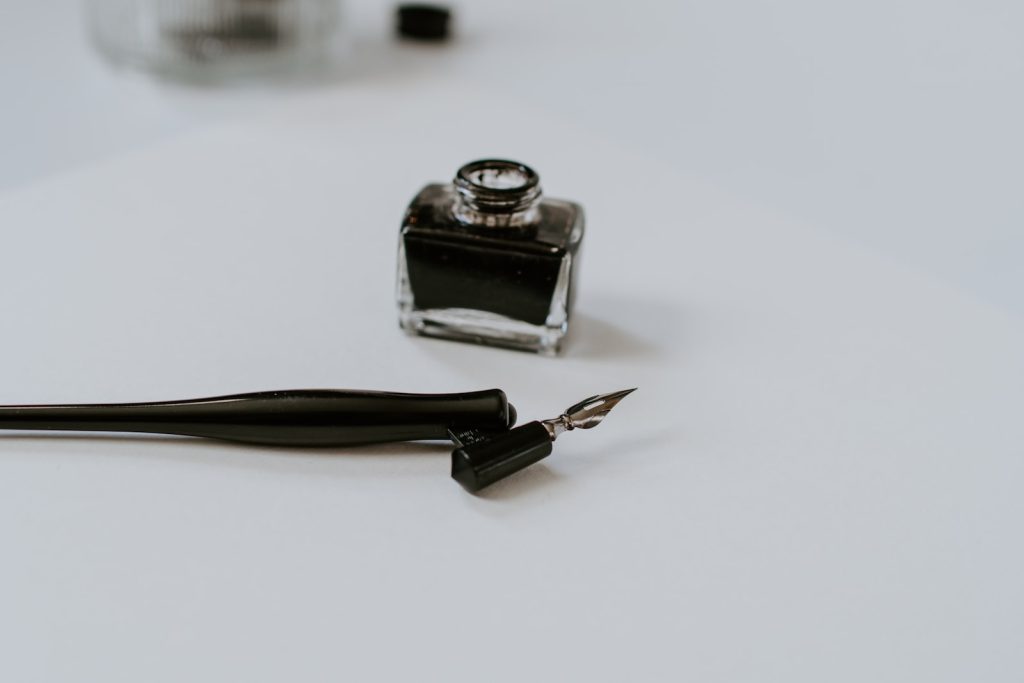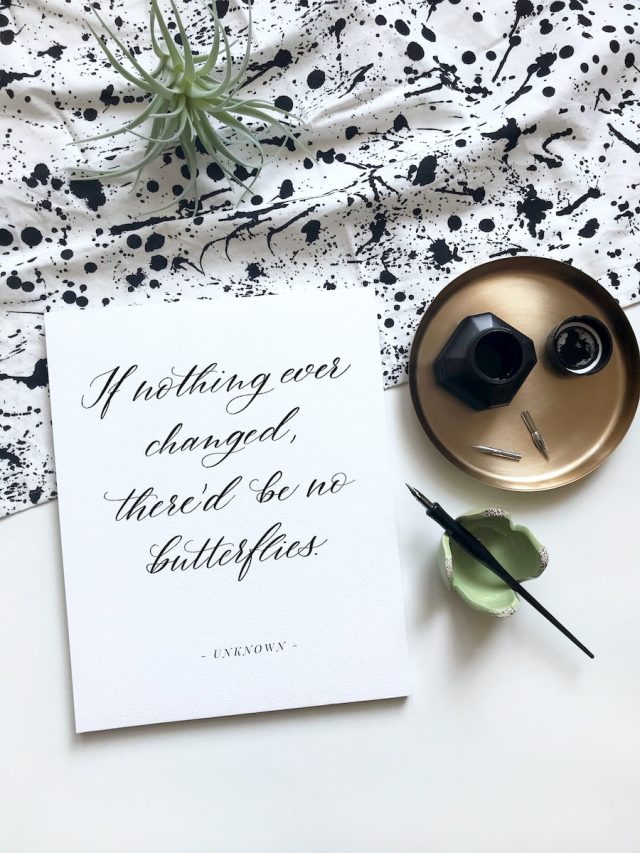If you’ve ever been mesmerized by the intricate swirls and loops of calligraphy art, you’re not alone. Calligraphy is a timeless art form that has been around for centuries and is still beloved today. Whether you’re interested in creating beautiful handwritten notes or you simply want to explore a new artistic hobby, learning the basics of calligraphy can be a rewarding experience.
Calligraphy is more than just pretty writing; it combines technique, skill, and creativity. From mastering the right tools to understanding the importance of spacing and letter formation, calligraphy can initially seem intimidating. However, with the right guidance and practice, anyone can learn the basics of calligraphy and create their own stunning art pieces.
In this blog post, we’ll cover the fundamentals of calligraphy, including the different types of tools and materials you’ll need, the basic strokes and techniques, and some helpful tips to get you started. By the end of this post, you’ll have a solid understanding of calligraphy and be ready to start creating your own beautiful art pieces. So grab a pen and paper, and let’s dive into the world of calligraphy!
What is Calligraphy?
Calligraphy is an ancient art form that involves writing beautiful letters and symbols in a stylized manner. It is often considered to be a combination of writing and drawing, as calligraphers use specific tools and techniques to create stunning visual effects.
The word “calligraphy” comes from the Greek words “kallos,” meaning “beauty,” and “graphein,” meaning “to write.” This reflects the art form’s focus on creating aesthetically pleasing writing.
There are many different styles of calligraphy, each with its own unique characteristics and history. Some of the most well-known styles include Gothic, Italic, and Copperplate. Each style requires different tools and techniques to master; some may be more challenging than others.
Calligraphy has a rich cultural history, with many cultures worldwide developing their own unique styles and techniques over the centuries. From the elegant script of ancient China to the bold, graphic lettering of medieval Europe, calligraphy has played an important role in developing art, literature, and communication.
Today, calligraphy is still a popular art form and hobby, with many people learning the basics to create their own beautiful handwritten notes, invitations, and artwork. Whether you’re interested in learning a specific style or improving your handwriting, calligraphy is a fascinating and rewarding skill to master.
Supplies Needed

If you’re interested in learning calligraphy, you’ll need a few basic supplies to get started. The type of supplies you’ll need will depend on the style of calligraphy you want to learn, but here are some of the essentials you’ll need:
- Pen or Brush: The most important tool for calligraphy is the pen or brush. There are many different types of pens and brushes available, each with its own unique characteristics. Some of the most popular options include dip pens, fountain pens, and brush pens.
- Ink: Besides a pen or brush, you’ll need ink to create your calligraphy. Many different types of ink are available, from traditional bottled inks to more modern options like brush pens with pre-filled ink cartridges.
- Paper: You’ll also need a good quality paper to write on. Look for smooth, high-quality paper that won’t bleed or feather when you write on it.
- Guidelines: Guidelines are essential for creating consistent letterforms in calligraphy. You can either use pre-made guidelines or create your own using a ruler and pencil.
- Other Supplies: Depending on the calligraphy style you’re learning, you may need other supplies like a lightbox for tracing, a nib cleaner, or a water jar for cleaning your brushes.
Overall, calligraphy is a relatively affordable hobby to get into. While some more expensive supplies are available, you can start with just a few basic tools and still create beautiful calligraphy. As you progress, you may want to invest in higher-quality supplies to improve your technique and create more detailed artwork.
Types of Pens
There are many different types of pens used in calligraphy, each with its own unique characteristics and benefits. Here are some of the most common types of pens used in calligraphy:
- Dip Pens: Dip pens are one of the oldest and most traditional calligraphy pens. They consist of a nib, a metal tip that holds the ink, and a handle or holder. Dip pens are versatile and can create many letterforms, from thick and bold to delicate and fine.
- Fountain Pens: Fountain pens are a more modern option for calligraphy. They use a self-contained ink supply and have a nib that’s similar to a dip pen. Fountain pens are great for beginners because they’re easy to use and require less maintenance than dip pens.
- Brush Pens: Brush pens are another modern option for calligraphy. They have a brush-like tip that creates thick, bold strokes and can be used for various calligraphy styles.
- Marker Pens: Marker pens are similar to brush pens but have a felt tip instead of a brush tip. They’re great for creating bold, graphic lettering and are often used for modern calligraphy styles.
- Ballpoint Pens: While not typically used for traditional calligraphy, ballpoint pens can create modern lettering styles. They’re great for creating thin, consistent lines and are easy to find and affordable.
Overall, the type of pen you choose will depend on your personal preferences and the style of calligraphy you’re interested in learning. It’s a good idea to experiment with different types of pens to find the one that works best for you.
Making Basic Strokes
Learning calligraphy can initially seem intimidating, but it’s all about mastering a few basic strokes. Once you get the hang of these strokes, you’ll be able to create beautiful letterforms and experiment with different calligraphy styles. Here are some of the basic strokes you’ll need to master:
- Downstroke: The downstroke is created by applying pressure to the pen or brush as you move it down the page. It’s one of the most important strokes in calligraphy, as it creates the thick, bold lines that are characteristic of many calligraphy styles. So, don’t be afraid to put some weight into it!
- Upstroke: The upstroke is created by applying minimal pressure to the pen or brush as you move it up the page. It creates thin, delicate lines and is often used to create contrast with the thicker downstrokes.
- Loop: The loop is created by curving the pen or brush as you move it across the page. It’s a great way to add a bit of flair to your letterforms and can be used to create a variety of decorative elements.
- Dot: The dot is created by gently tapping the pen or brush on the page. It’s a simple stroke but is essential for creating punctuation and other small details in your calligraphy.
Remember, calligraphy is all about practice and experimentation. Don’t be afraid to make mistakes and try new things! As you master these basic strokes, you’ll be able to create your own unique style and add your own personal flair to your calligraphy. So grab your pen or brush, put on some music, and let’s get practicing! Who knows, you might just surprise yourself with how quickly you pick it up.
Practice Exercises
Practice is key when it comes to learning calligraphy. Here are some exercises to help you improve your skills and master the basics:
- Warm-up Exercises: Before you start working on specific letterforms or words, it’s a good idea to warm up your hand with some simple exercises. Try writing circles, lines, and loops to get your hand accustomed to the movements required for calligraphy.
- Alphabet Practice: Practice writing the letters of the alphabet, both uppercase and lowercase. Start with simple letters and work your way up to more complex ones. Use guidelines to ensure consistency in your letterforms.
- Word Practice: Once you’re comfortable with writing individual letters, start practicing writing whole words. Choose a few words you’d like to master, such as your name or favorite quote, and practice writing them in different calligraphy styles.
- Copying Exercises: Copying the work of other calligraphers is a great way to improve your skills and learn new techniques. Find examples of calligraphy you admire and try to recreate them, paying close attention to the letterforms and strokes used.
- Experimentation Exercises: Don’t be afraid to experiment and try new things! Play with different pens, inks, and paper types, and try different styles and techniques to find what works best for you.
Remember, the key to success in calligraphy is consistent practice. Set aside a few minutes each day to work on your skills, and don’t get discouraged if you make mistakes along the way. With time and practice, you can create beautiful calligraphy you can be proud of!
Conclusion: Express Your Creativity
In conclusion, calligraphy is a fun and rewarding hobby that allows you to express your creativity in a unique way. With a little practice and experimentation, you can master the basics of calligraphy and create beautiful letterforms that will impress you.
So don’t be afraid to let your creative side shine through! Whether you’re writing a love letter, creating a piece of art, or just doodling in your notebook, calligraphy is a great way to add a personal touch to your work. And who knows, you might just discover a hidden talent that you never knew you had!
So grab your pens, markers, or brushes, and get ready to unleash your inner calligrapher. Remember, the most important thing is to have fun and enjoy the process. And who knows, maybe one day you’ll be the next great calligrapher, impressing everyone with your stunning letterforms and witty remarks.






























